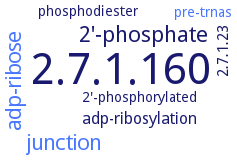2.7.1.160: 2'-phosphotransferase
This is an abbreviated version!
For detailed information about 2'-phosphotransferase, go to the full flat file.

Word Map on EC 2.7.1.160 
-
2.7.1.160
-
2'-phosphate
-
junction
-
adp-ribose
-
adp-ribosylation
-
2.7.1.23
-
phosphodiester
-
2'-phosphorylated
-
pre-trnas
- 2.7.1.160
-
2'-phosphate
- junction
- adp-ribose
-
adp-ribosylation
-
2.7.1.23
-
phosphodiester
-
2'-phosphorylated
- pre-trnas
Reaction
Synonyms
2'-phosphotransferase, ApeTpt1, AtPt, CTHT_0025470, HeLa cell 2'-phosphotransferase, human TRPT1, KptA, kptA1, mTPT1, NAD+-dependent 2'-phosphotransferase, NAD-dependent RNA 2'-phosphotransferase, RNA 2'-phosphotransferase, RslTpt1, Tpt1, Tpt1p, tRNA 2'-phosphotransferase, Trpt1, yeast 2'-phosphotransferase
ECTree
Advanced search results
Cloned
Cloned on EC 2.7.1.160 - 2'-phosphotransferase
Please wait a moment until all data is loaded. This message will disappear when all data is loaded.
expression in Escherichia coli
expression in Escherichia coli as a His-6 fusion, expression in Saccharomyces cerevisiae tpt1 mutant
expression in Saccharomyces cerevisiae tpt1 mutant strain Y2, the human TRPT1 gene could complement this mutation
expression in Saccharomyces cerevisiae tpt1 mutant strain Y2, the wild-type yeast TPT1 could complement this mutation
-
expression in Saccharomyces cerevisiae tpt1 mutants
Fusion of the coding region of the splicing enzyme in-frame to the amino-terminus of the green fluorescent protein (GFP). Full-length 2'-phosphotransferase cDNA (289 aa) and a short version of the same polypeptide starting with the second methionine at position 33 are fused to the coding region of GFP. Additionally, the N-terminal sequence of 97 amino acids derived from the 2'-phosphotransferase is directly fused to GFP.
-
gene CTHT_0025470, recombinant expression of His6-tagged enzyme in Escherichia coli strain BL21(DE3)
Thermochaetoides thermophila
gene kptA, encoded in an operon-like cluster with genes encoding RNA polymerase, RNA ligase, and the Hen1/Pnkp RNA repairsystem reported to repair ribotoxin-degraded tRNAs in vitro
gene kptA, genomic organization, comparisons
gene kptA, genomic organization, comparisons, the gene kpta neighborhood includes the genes coding for: (i) the enzyme Nam phosphoribo-syltransferase (NadV), involved in the recycling to NAD of Nam, thepyridine product of the KptA-catalyzed reaction, (ii) the orthologue of the yeast ADPR-1-P phosphatase, implicated in the conversionto ADPR of the adenylylic product, (iii) the enzyme ADPR diphosphatase (ADPRP), responsible for ADPR hydrolysis to AMPand R5P, and (iv) the enzyme PRPP synthetase, which catalyzes PRPP formation from ATP and ribose 5-phosphate
gene kptA, recombinant expression of His6-tagged enzyme in Escherichia coli strain BL21(DE3)
gene TPT1, recombinant expression of His6-tagged enzyme in Escherichia coli strain BL21(DE3)
recombinant expression of His6-tagged wild-type and mutant enzymes in Escherichia coli strain BL21(DE3)
-
the enzyme RslTpt1 is encoded within a putative RNA repair gene cluster, recombinant expression of wild-type RslTpt1 and mutant R16A/H17A/R64A/R119A RslTpt1 in Saccharomyces cerevisiae tpt1DELTA haploid strain YBS501, in which the TPT1 ORF is deleted and replaced by LEU2 and which is dependent for viability on the p360-TPT1 plasmid (CEN URA3 SceTPT1), recombinant expression of His6-tagged wild-type RslTpt1 and mutant R16A/H17A/R64A/R119A RslTpt1 in Escherichia coli strain L21(DE3)-CodonPlus
-
The murine Trpt1 gene is targeted in E14 ES cells with a positive/negative selection vector. Trpt1 gene is disrupted by homologous recombination in ES cells, deleting exons 3, 4, and part of exon 5 that encode amino acids 48-173. Clones from two individually selected heterozygous ES cell lines are injected into blastocysts and the resultant founder chimeras bred to obtain two lines of Trpt1+/- and Trpt1-/-mice that are both viable and healthy and are normally fertile. Cell culture: Trpt1+/+ and Trpt1-/-cell lines are obtained by serial passage of SV40-T-antigen transfected mouse embryonic fibroblasts.
-
expression in Escherichia coli as a His-6 fusion, expression in Saccharomyces cerevisiae tpt1 mutant

-
expression in Escherichia coli as a His-6 fusion, expression in Saccharomyces cerevisiae tpt1 mutant
-
gene kptA, recombinant expression of His6-tagged enzyme in Escherichia coli strain BL21(DE3)
gene kptA, recombinant expression of His6-tagged enzyme in Escherichia coli strain BL21(DE3)
gene kptA, recombinant expression of His6-tagged enzyme in Escherichia coli strain BL21(DE3)


 results (
results ( results (
results ( top
top





